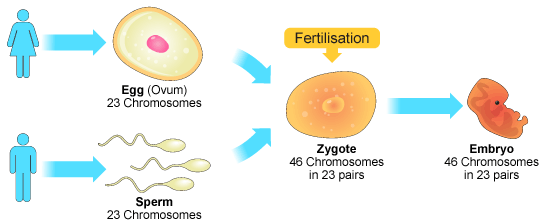Like other living things, human beings reproduce. It's what keeps the
population going. In humans, the male and female reproductive systems
work together to make a baby.
Fertilisation
During sexual intercourse the man's penis releases semen into
the woman's vagina. Sperm cells travel in semen from the penis and into
the top of the vagina. They enter the uterus through the cervix and
travel to the egg tubes. If a sperm cell meets with an egg cell there,
fertilisation can happen. Fertilisation happens when an egg cell meets
with a sperm cell and joins with it.
The fertilised egg divides to form a ball of cells called an embryo. This attaches to the lining of the uterus and begins to develop into a foetus (pronounced "fee-tuss") and finally a baby.
Female Reproductive System
Ovaries
The two ovaries contain hundreds of undeveloped female sex cells called egg cells or ova. Women have these cells in their bodies from birth - whereas men produce new sperm continually.
Egg tubes
Each ovary is connected to the uterus by an egg tube. This is sometimes called an oviduct or Fallopian tube. The egg tube is lined with cilia,
which are tiny hairs on cells. Every month, an egg develops and becomes
mature, and is released from an ovary. The cilia waft the egg along
inside the egg tube and into the uterus.
Uterus and cervix
The uterus is also called the womb. It is a muscular bag with a soft lining. The uterus is where a baby develops until its birth.
The cervix is a ring of muscle at the lower end of the uterus. It keeps the baby in place while the woman is pregnant.
Vagina
The vagina is a muscular tube that leads from
the cervix to the outside of the woman's body. A man's penis goes into
the woman's vagina during sexual intercourse. The opening to the vagina
has folds of skin called labia that meet to form a vulva. The urethra also opens into the vulva, but it is separate from the vagina, and is used for passing urine from the body.
ACTIVITY
Female Reproductive System
FEMALE REPRODUCTIVE SYSTEM I
FEMALE REPRODUCTIVE SYSTEM II
APARATO REPRODUCTOR FEMENINO
Female Reproductive System
FEMALE REPRODUCTIVE SYSTEM I
FEMALE REPRODUCTIVE SYSTEM II
APARATO REPRODUCTOR FEMENINO
About the Male Reproductive System
Most species have two sexes: male and female. Each sex has its own unique reproductive system. They are different in shape and structure, but both are specifically designed to produce, nourish, and transport either the egg or sperm.Unlike the female, whose sex organs are located entirely within the pelvis, the male has reproductive organs, or genitals, that are both inside and outside the pelvis. The male genitals include:
- the testicles
- the duct system, which is made up of the epididymis and the vas deferens
- the accessory glands, which include the seminal vesicles and prostate gland
- the penis
Testes
The two testes (one of them is called a testis) are contained in a bag of skin called the scrotum. They have two functions:- to produce millions of male sex cells called sperm
- to make male sex hormones, which affect the way a man's body develops.
Sperm duct and glands
The sperm pass through the sperm ducts, and mix with fluids produced by the glands. The fluids provide the sperm cells with nutrients. The mixture of sperm and fluids is called semen.Penis and urethra
The penis has two functions:- to pass urine out of the man's body
- to pass semen into the vagina of a woman during sexual intercourse.
http://www.bbc.co.uk/bitesize/ks3/science/organisms_behaviour_health/reproduction/revision/1/
ACTIVITY
Male Reproductive System
BIRTH
PUBERTY
EL APARATO REPRODUCTOR MASCULINO
THE MALE REPRODUCTIVE SYSTEMBIRTH
PUBERTY
VIDEO
SELF-EVALUATION
Clear the mind
Clear the mind












